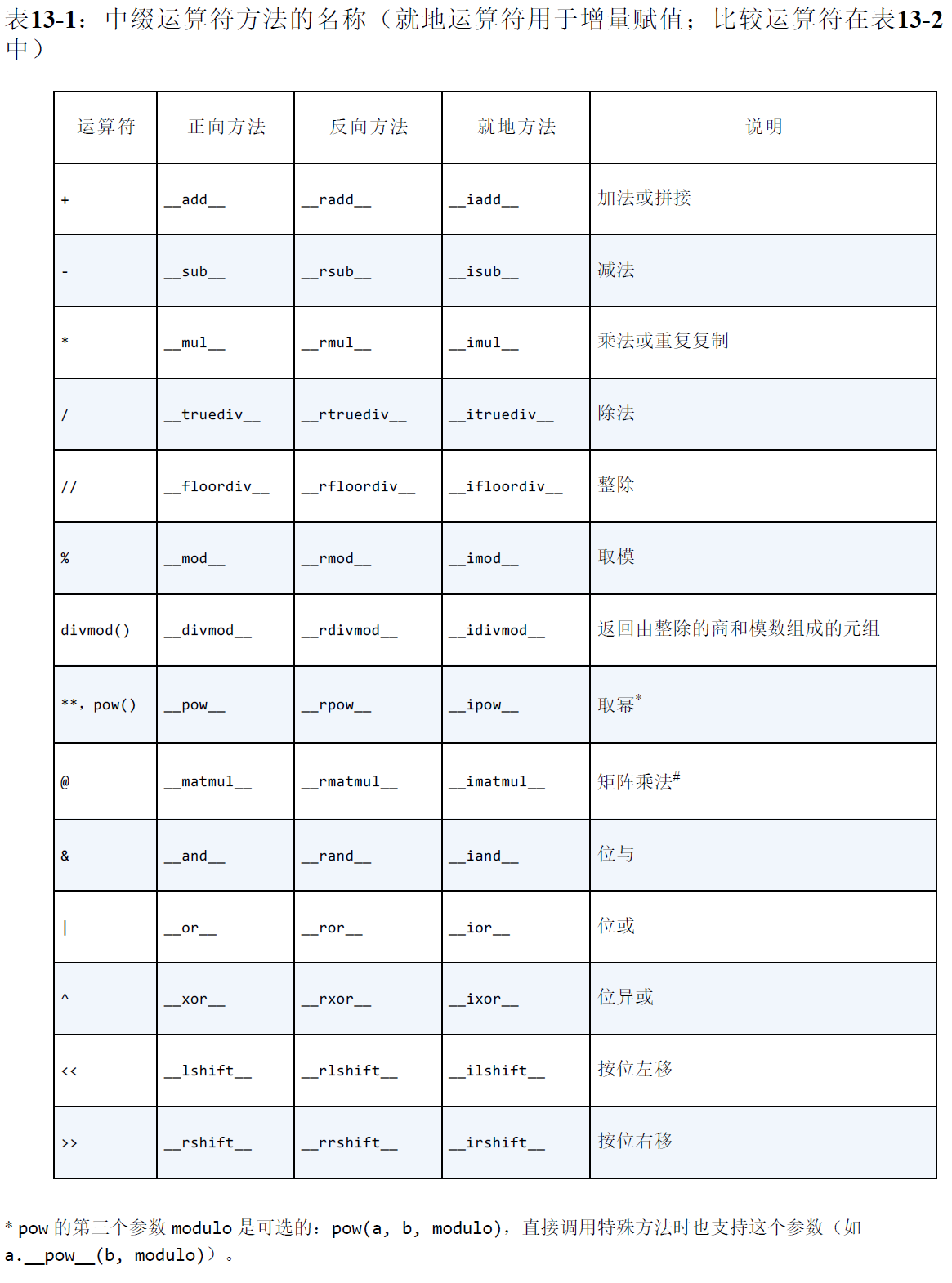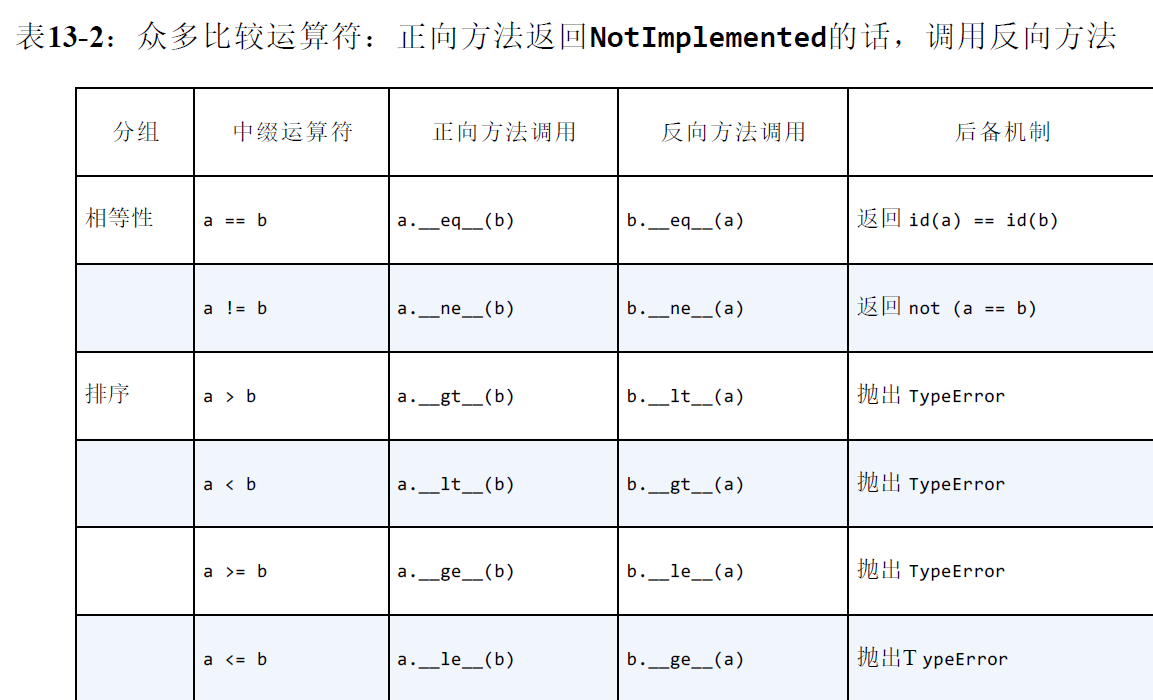python对运算符重载的一些限制
1.不能重载内置类型的运算符
2.不能新建运算符,只能重载现有的
3.某些运算符不能重载:is、and、or、not
建立某Vector类

1 from array import array 2 import reprlib 3 import math 4 5 6 class Vector: 7 typecode = 'd' 8 shortcut_names = 'xyzt' 9 10 def __init__(self, components): 11 self._components = array(self.typecode, components) 12 13 def __iter__(self): 14 return iter(self._components) 15 16 def __repr__(self): 17 components = reprlib.repr(self._components) 18 components = components[components.find('['):-1] 19 return 'Vector({})'.format(components) 20 21 def __str__(self): 22 return str(tuple(self)) 23 24 def __bytes__(self): 25 return (bytes([ord(self.typecode)]) + bytes(self._components)) 26 27 def __eq__(self, other): 28 return tuple(self) == tuple(other) 29 30 def __abs__(self): 31 return math.sqrt(sum(x * x for x in self)) 32 33 def __bool__(self): 34 return bool(abs(self)) 35 36 @classmethod 37 def frombytes(cls, octets): 38 typecode = chr(octets[0]) 39 memv = memoryview(octets[1:]).cast(typecode) 40 return cls(memv)
重载一元运算符
- (__neg__) 一元取负运算符
+ (__pos__) 一元取正运算符
~ (__invert__) 对整数按位取反
(__abs__) 取绝对值
实现它们:
def __neg__(self): return Vector(-x for x in self) #创建一个新的Vector实例,把self的每个分量都取反 def __pos__(self): return Vector(self) #创建一个新的Vector实例,传入self各个分量
__invert__不实现是因为,计算~v时python会抛出TypeError,且输出详细的错误信息,这符合预期。
!!注意:x和+x可能不相等,例如
import decimal ctx = decimal.getcontext() #获取当前全局算术运算的上下文引用 ctx.prec = 40 #把算术运算上下文精度设置为40 one_third = decimal.Decimal('1') / decimal.Decimal('3') #计算1/3 print(one_third) print(one_third == +one_third) # ctx.prec = 28 #把精度降低为28,默认精度 print(one_third == +one_third) print(+one_third) 0.3333333333333333333333333333333333333333 True False #one_third == +one_third返回False 0.3333333333333333333333333333 #小数点后位是28位而不是40位
重载 + 运算符
两个向量加在一起生成一个新向量,如果两个不同长度的Vector实例加一起呢,可以抛出错误,但最好是用0填充,那么可以:
def __add__(self, other): pairs = itertools.zip_longest(self, other, fillvalue=0) return Vector(a + b for a, b in pairs) #pairs是一个生成器,生成(a, b)形式元组,a来自self,b来自other,0填充
尝试调用:
if __name__ == '__main__': V1 = Vector([3, 4, 5]) V2 = V1 + (2, 3, 4, 5) print(repr(V2)) V3 = (2, 3, 4, 5) + V1 print(repr(V3)) #结果 Vector([5.0, 7.0, 9.0, 5.0]) TypeError: can only concatenate tuple (not "Vector") to tuple
实现的加法可以处理任何数值可迭代对象,但是对调操作数加法就会失败。实际上a + b调用的是a.__add__(b),而b + a自然是调用b.__add__(a)。而(2,3,4,5)显然没有实现这样的加法,如何解决?
为了支持涉及不同类型的运算,python为中缀运算符提供了特殊的分派机制。对于表达式a + b来说,解释器会执行以下几步操作:
(1)如果a有__add__方法,而且返回值不是NotImplemented,调用a.__add__(b),然后返回结果。
(2)如果a没有__add__方法,或者__add__方法返回值是NotImplemented,检查b有没有__radd__方法,如果有而且没有返回NotImplemented,调用b.__radd__(a),然后返回结果。
(3)如果b没有__radd__方法,或者__radd__方法返回值是NotImplemented,抛出TypeError,并在错误消息中指明操作类型不支持。

__radd__是__add__的反向版本。那么加法可以这样写:
def __add__(self, other): pairs = itertools.zip_longest(self, other, fillvalue=0) return Vector(a + b for a, b in pairs) def __radd__(self, other): return self + other #__radd__直接委托__add__
新问题是,如果操作类型是单个数或者‘helloworld’这样的字符串抛出的错误不合理:
V1 = Vector([3, 4, 5]) V2 = V1 + 1 #TypeError: zip_longest argument #2 must support iteration V1 = Vector([3, 4, 5]) V2 = V1 + 'abc' #TypeError: unsupported operand type(s) for +: 'float' and 'str'
由于类型不兼容而导致运算符特殊方法无法返回有效的结果,那么应该返回NotImplemented,而不是TypeError。返回NotImplemented时,另一个操作数所属的类型还有机会执行运算,即python会尝试调用反向方法。
def __add__(self, other): try: pairs = itertools.zip_longest(self, other, fillvalue=0) return Vector(a + b for a, b in pairs) except TypeError: return NotImplemented def __radd__(self, other): return self + other
发生TypeError时,解释器尝试调用反向运算符方法,如果操作数是不同的类型,对调之后可能反向运算符可以正确计算。
重载 * 运算符
向量 * x,如果x是数值,就是向量每个分量乘以x。
def __mul__(self, other): return Vector(n * other for n in self) def __rmul__(self, other): return self * other
问题是:提供不兼容的操作数就会出问题,other需要的参数是数字,传入bool类型,或者fractions.Fraction实例等就会出问题。
这里采用类型检测,但是不硬编码具体类型,而是检查numbers.Real(因为不可能是复数)抽象基类,这个抽象基类涵盖了所有可能可以参与这个运算的类型。
def __mul__(self, other): if isinstance(self, numbers.Real): return Vector(n * other for n in self) else: return NotImplemented def __rmul__(self, other): return self * other
中缀运算符见表:

重载比较运算符
比较运算符区别于+ * / 等:
(1) 正向反向调用使用的是同一系列方法,规则如表13-2.例如__gt__方法调用反向__lt__方法,并且把参数对调。
(2)对于==和!=来说,如果反向调用失败,python会比较对象ID,而不抛出TypeError。

仅仅比较长度以及各个分量显然是不合理的,因该加上类型检查:
def __eq__(self, other): if isinstance(other, Vector): return len(self) == len(other) and all(a == b for a, b in zip(self, other)) else: return NotImplemented
对于!=运算符,从object继承的__ne__方法后备行为满足了需求:定义了__eq__方法且不返回NotImplemented时,__ne__会对__eq__返回的结果取反。
(事实上可能x==y成立不代表x!=y不成立,有时需要定义__ne__方法)
object继承的__ne__方法即是下面代码的C语言版本:
def __ne__(self, other): eq_result = self == other if eq_result is NotImplemented: return NotImplemented else: return not eq_result
重载增量赋值运算符
对于Vector类,它是不可变类型,是不能实现 += 这样的就地方法的。
某可变的类型:
class B(A): def __add__(self, other): if isinstance(other, A): return B(self.某属性+other.某属性) else: return NotImplemented def __iadd__(self, other): if isinstance(other, A) other_iterable = other.某属性 else: try: other_iterable = iter(other) except TpyeError: #抛出xxx错误 使用other_iterable更新self return self
以上来自《流畅的python》
